Flamethrower-heavy fighting vehicle (BMO-T)
The BMO-T is made on the basis of a tank chassis, without significant alteration of the hull, except for the crew compartment and the roof. A special box-shaped armored superstructure was mounted around the control and combat compartments, the walls of which together with the control compartment form the habitable compartment in which the crew seats are located: the driver and the commander, as well as the grenade throwers of the 7 man. The ammunition set of launch pipes RPO "Bumblebee" is 32 units, which are stored in the habitable compartment and additional packing on the left fiddle shelf. RPO occupy a significant amount and during transportation are stored in special racks with quick release fasteners.
The armor protection of the frontal part of the BMO-T hull is made at the T-72 MBT level, the side superstructures are made separated with the installation of dynamic protection, fuel tanks and auxiliary equipment. The side walls are extended from the stern to the logging part and have internal sections for various transportable equipment. On the sides of the hull can be installed additional power screens, equipped with dynamic protection. Heavy combat vehicle flamethrower has armor on the level of modern MBT, low silhouette and low complexity of the alteration of the base tank chassis. The mass of the machine is 43,9 tons.
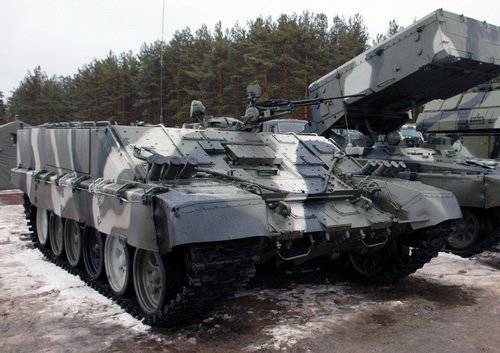
The BMO-T provides flamethrowers with a higher level of protection, comfort, and ergonomic working conditions compared to machines that were built on the basis of the BMP-1 / 2. The BMO-T can be used as part of tank formations and motorized infantry brigades in the fight against well-fortified enemy firing points, including pillboxes. In this case, the machine can be used autonomously, carrying out the tasks of destroying individual enemy groups and their temporary defensive structures. The BMO-T provides the assault force with the ability to land safely in combat conditions, through the landing hatches located in the aft part of the armor superstructure, at the same time the landing in front and from the sides is covered with an armored superstructure, side walls and raised doors.
Description of construction, booking
The basic tracked chassis is the chassis of the T-72 with its engine-transmission compartment, undercarriage and armored hull with dynamic protection and control compartment. The driver's hatch has an axial location. The BMO-T hull, instead of the roof of the fighting compartment of the tank, has an armor superstructure covering its sides, which, together with the front head-plate, sides, bottom and engine bulkhead, forms a combined control compartment with a landing compartment in which the vehicle commander and flame throwers are located. On the roof of the superstructure, with an offset to the left, there is an opening with an on-board propulsion system - a pivot-mounted device, on which is mounted a rotating commander's turret with a hatch and an installed anti-aircraft machine-gun unit with remote control.
On a fixed pursuit of a turntable through the brackets inside the compartment, the seat of the vehicle commander is mounted. To the sides of the chassis body are attached flamethrower seats. Ammunition of flamethrowers is placed in a traveling manner in spaced racks having a quick-release fastener. One rack is located to the right of the commander's seat in the transverse plane of the BMO-T, the second one is to the left of the commander's seat along the board, shifted towards the control compartment. The third rack is located in the longitudinal section of the machine between the seats of the landing.
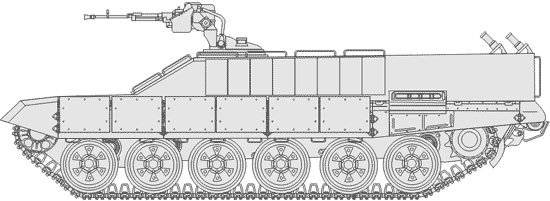
Hatches for landing are located on the superstructure's roof and in its rear part. Spring-loaded steps are installed on the aft sheet of the BMO-T hull, which provide more convenient landing and landing of flame throwers. In order for the paratroopers to observe what is happening on the battlefield, surveillance devices were installed in the roof of the superstructure.
The greatest protection is provided in the frontal projection, where the frontal hull of the hull of the base tank passes into the front wall of the superstructure with spaced armor, built-in dynamic protection and combined armor packages. In the frontal projection of the BMO-T has an ordering reservation. If we talk about the protection from the sides, then it is provided by side plates with dynamic protection, as well as cavities filled with fuel tanks, batteries, filtering unit and control gear. On the inner side of the detachment of the assault force installed anti-splinter podboy According to the developers of the BMO-T, the onboard booking reliably protects the crew and the landing force against most of the modern anti-tank weapons used by infantrymen in the melee.
weaponry
To combat the enemy's manpower and self-defense against low-flying air targets, a BMN-T is equipped with a closed-type 12,7-mm machine-gun unit with remote control. As the main armament used anti-aircraft 12,7 mm. machine gun NSV. Its ammunition is 1000 cartridges. In addition to the machine gun, the machine carries 32 units 93-mm flamethrower RPO-A "Bumblebee". Also for the installation of smoke screens 12 81-mm grenade launchers of the 902A system from the structure of the electro-optical active protection against high-precision armament “Shtor” are used.
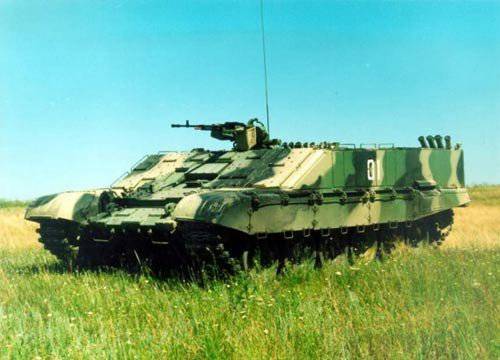
The basic one weapons the BMO-T assault force is a Bumblebee rocket infantry flamethrower, created in 1976 in the Tula Instrument Engineering Design Bureau. The flamethrower was put into service at the end of 80-ies, replacing the troops of the RPO "Lynx". RPO-A "Bumblebee" is a disposable flamethrower. Its barrel-container is used to transport and launch a single capsule, after a shot the container can be thrown away. Inside the barrel is a capsule containing an incendiary mixture and a powder engine. During the shot, the powder engine accelerates the capsule in the barrel bore and, separating from the charge, flies back along with the powder gases from the shot. The flight of an incendiary capsule is stabilized with the help of its tail unit. The flamethrower has a sighting device of the frame type with a fully mobile, sighting range of shooting is 600 meters.
The main type of charge is thermobaric. This charge is intended for the destruction of sheltered fire means in the field, in the city, in the mountains, as well as for the destruction of various shelters, the destruction of automotive and lightly armored vehicles. An RPO-A ammunition in an open area creates an overpressure of 0,4-0,8 kg / cm2 at a distance of 5 meters from the epicenter of the explosion and up to 4-7 kg / cm2 - in a room of up to 90 cubic meters. A shockwave from an explosion may “leak” into shelters, trenches, etc. In the zone of detonation transformations of the thermobaric mixture, oxygen is completely burned out, and the temperature reaches 800 degrees Celsius.
Means of observation and communication
To monitor the situation on the battlefield, the commander of the machine has the following observation devices:
The observation device electrical heating TNPO-160;
Surveillance device commander TKN-3;
The illuminator OU-3GK, which has an infrared filter.
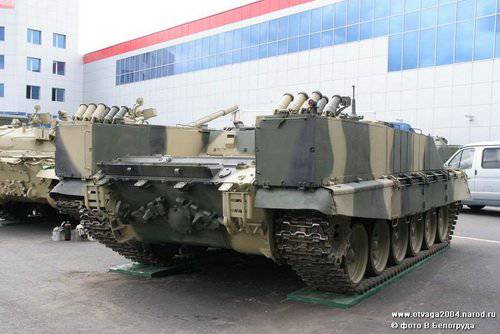
At the disposal of the driver of the machine are the following observation devices:
The device monitoring TNPA-65;
The device of observation of the driver electrically heated TNPO-168В;
Infrared headlight FG-125;
Night surveillance device mechanic driver TVNE-4B.
The paratroopers have a TNN-2 surveillance device 65, a TNP-2 surveillance device, and a 165 rearview surveillance device TNPT-3.
To ensure communication in the car uses the radio station P-174.
Engine and chassis
The multi-fuel engine B-84-1 or B-84М is installed on the combat vehicle of the flame throwers as a power plant, which develops power up to the HP 840. and is able to accelerate the car to 60 km / h when driving on a highway and to 30-40 km / h when driving on rough terrain. BMO-T has several fuel tanks. The volume of the nasal is - 347 liters, the volume of the onboard - 961 liter. Cruising on the highway is 712 km. An 2-speed air cleaner with ejection removal is used to remove dust from the dust collector. In it, the role of the 1-th stage is played by the cyclone apparatus, and the role of the 2-th special cassettes.
The main system is the air launch system, which is duplicated by the electric one. In addition, intake air heating systems and a nozzle oil and coolant preheater are used to facilitate the injection. The AK-150CB two-cylinder piston compressor is used as the air system of the power plant; its working pressure is 120-160 kgf / cm.
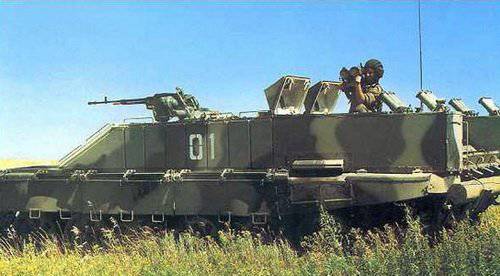
The power transmission is made mechanical with a step-up gearbox, coaxial gears and onboard gearboxes. The boost reducer has drives for the starter, compressor and cooling fan. Manual transmission with hydraulic clutches. The BMO-T has 8 transmissions - 7 front and 1 rear.
The BMO-T uses the T-72 tracked tank propulsion unit. Driving wheels are at the back. The track is made of metal with two types of hinges: metal or rubber-metal. Each track consists of 97 links. Two-disk skating rinks with external shock absorption act as support rollers, there are 6 rollers on each side. Single-support rollers with internal depreciation are used as supporting ones - on the 3 roller to each side.
The suspension is made individually torsion, on the 1, 2 and 5 track rollers are paddle hydraulic shock absorbers.
Information